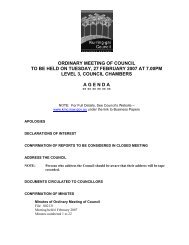Ku-ring-gai Heritage Conservation Areas North Inventory Sheet
Ku-ring-gai Heritage Conservation Areas North Inventory Sheet
Ku-ring-gai Heritage Conservation Areas North Inventory Sheet
Create successful ePaper yourself
Turn your PDF publications into a flip-book with our unique Google optimized e-Paper software.
<strong>Ku</strong>-<strong>ring</strong>-<strong>gai</strong><br />
<strong>Heritage</strong> <strong>Conservation</strong> <strong>Areas</strong> <strong>North</strong> <strong>Inventory</strong> <strong>Sheet</strong><br />
Item No<br />
Item Name<br />
Item Type<br />
Group Collection<br />
Category<br />
Key Historical<br />
Periods<br />
Primary Address<br />
Local Govt. area<br />
HCA 23<br />
WARRAWEE HERITAGE CONSERVATIONA AREA<br />
<strong>Heritage</strong> <strong>Conservation</strong> Area<br />
Urban Area<br />
Townscape<br />
1890-1910s; Inter-war 1920s-1930s; 1940s-1960s<br />
Refer to map<br />
<strong>Ku</strong>-<strong>ring</strong>-<strong>gai</strong><br />
Boundaries<br />
<strong>North</strong>: Across Warrawee Avenue along the northern boundary of properties at Nos 16 and 19<br />
Warrawee Avenue and 33A Bangalla Street, along the north boundary of Gillespie Field, and across<br />
Young Street along the north boundary of 11 Young Street; East: following the eastern boundaries of<br />
properties at 1A-11 Young Street, encompassing propeties at 19 and 17 Bangalla Street, and then<br />
following Cherry Street down to No. 23-25 Cherry St; South: the south boundaries of properties at 23<br />
-25 Cherry Street, 36-42A Hastings Road, encompassing properties at 65 and 67 Brentwood Avenue,<br />
and then following the northern side of the railway line; west: encompassing 44 & 37A Bangalla St,<br />
then following western boundaries of properties at Nos. 12-16 Warrawee Avenue<br />
National Historic Themes<br />
State Historic Theme 1<br />
State Historic Theme 2<br />
State Historic Theme 3<br />
State Historic Theme 4<br />
Building settlements towns and cities<br />
Towns, suburbs and villages<br />
Persons<br />
Domestic Life<br />
Summary<br />
Statement of<br />
Significance<br />
Warrawee <strong>Heritage</strong> <strong>Conservation</strong> Area is of aesthetic significance for its remarkable concentration<br />
of architecturally distinguished houses set within fine landscaped garden settings on large sites,<br />
many of the houses designed by notable architects including Eleanor Cullis-Hill, John Horbury<br />
Hunt, H. Joseland, Joseland & Gillings, Maurice B. Halligan, John Sulman, Hugh Venables Vernon,<br />
Waterhouse & Lake, and Wilson, Neave & Berry. Fine gardens blend with regenerated native trees<br />
and the undulating topography to create an aesthetically fine residential landscape.<br />
Warrawee <strong>Heritage</strong> <strong>Conservation</strong> Area is of historical significance as an exclusively residential<br />
area, which retains evidence of its early settlement, subdivision and continuing development, in its<br />
main road pattern created in the 1890s, and evidence of later subdivision of earlier estates such as<br />
the Pibrac Estate subdivision of 1920, which created Pibrac Avenue. A notable feature of the area’s<br />
layout, which is of historical significance, is the early creation of battleaxe allotments from the 1917<br />
subdivision of the Warrawee Garden Estate.<br />
The area is also of historical significance for its collection of early houses associated with<br />
prominent historical figures including Pibrac, the home of Frederick Eccleston Du Faur (1832<br />
-1915); Roseburn and Kooyong designed for two of the Gillespie brothers, proprietors of Anchor<br />
Flour Mills and prominent benefactors of Knox Grammar School, and Audley, designed for Preston<br />
L. Gowing of Gowings department stores.<br />
Warrawee was a prime timber-getting location from circa 1815, dominated by the holdings of timber<br />
contractor Thomas Hyndes to the east and west of Lane Cove Road (now the Pacific Highway).<br />
Hyndes’ land included vast stands of cedar, mahogany, turpentine, ironbark and blue gum. Hyndes<br />
had formally leased the 2000 acres (809ha) to the east of Lane Cove Road by 1822 and in 1840 the<br />
land was re-leased to John Terry Hughes, a prominent merchant and brewer, to whom a deed of<br />
KU-RING-GAI HERITAGE CONSERVATION AREAS NORTH INVENTORY

















